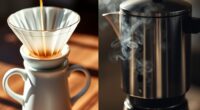Grind retention in your espresso grinder can secretly hurt your shot quality by causing uneven doses and inconsistent extracts. Residual grounds build up in burr chambers, hoppers, and chutes, trapping flavors and aroma or introducing off-flavors over time. Regular cleaning and proper calibration help minimize retention, leading to fresher grounds and more consistent espresso. To master these secrets and improve your coffee game, explore the full guide for practical tips and techniques.
Key Takeaways
- Residual grounds in grinders cause uneven dosing, affecting espresso consistency and flavor quality.
- Regular cleaning and calibration are essential to reduce grind retention and maintain optimal shot extraction.
- Grinder design features like burr alignment and grind size influence how much coffee is retained.
- Measuring grind retention with precise tools helps identify buildup and guides effective cleaning routines.
- Proper bean storage and grinding just before brewing preserve freshness and minimize residue that impacts taste.
Understanding Grind Retention and Why It Matters
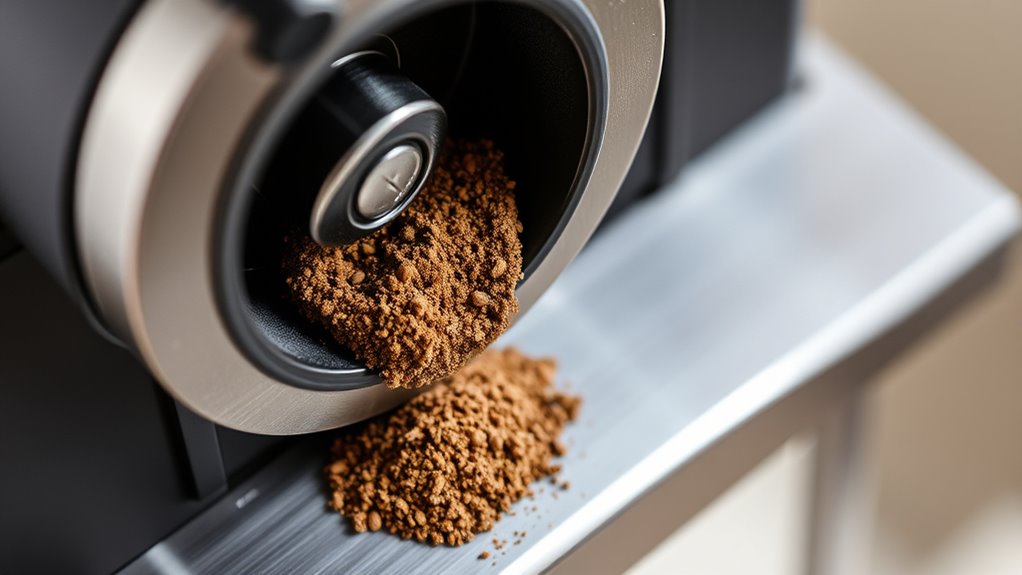
Understanding grind retention is essential because it directly impacts the consistency and quality of your espresso. When your grinder has high grind retention, residual grounds stay in the machine, which can lead to uneven dosing and compromised grind consistency. This inconsistency affects extraction, resulting in unpredictable flavors and weaker shots. To achieve ideal espresso, you need accurate dosing, which relies on minimizing leftover grounds. Proper calibration and regular cleaning help guarantee that each dose is precise and consistent. Recognizing how grind retention influences your process allows you to troubleshoot issues early and maintain a steady workflow. Additionally, automation technologies from other industries, like automation in business, exemplify how embracing innovative solutions can enhance efficiency. Ultimately, controlling grind retention helps you produce better espresso, with balanced extraction and rich flavor, every time you brew.
How Your Grinder Stores and Holds Coffee Grounds
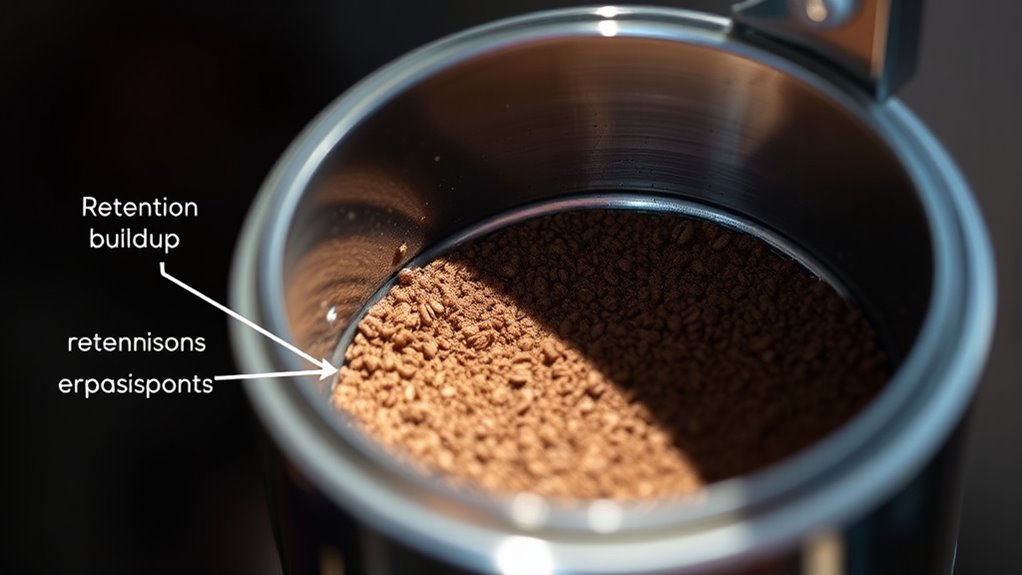
Your grinder’s design determines how coffee grounds are stored and retained after grinding. When grounds stick around, they can build up and affect flavor extraction with each shot. Understanding how this accumulation works helps you maintain freshness and consistent espresso quality. Additionally, the way your grinder manages ground retention can influence the overall brewing process and flavor profile.
Grounds Accumulation Mechanics
Grounds accumulation occurs as coffee particles travel through the grinder’s mechanisms, eventually settling in specific areas designed to hold them. As you adjust burr calibration, the grind size influences how grounds move and settle, impacting grind uniformity. Understanding this helps prevent buildup. Here’s how grounds accumulate:
- Burr Chamber: Grounds often collect here if burr calibration isn’t precise, affecting grind consistency.
- Hopper: Coffee particles can settle in the hopper, especially if grounds aren’t cleared regularly.
- Discharge Chute: Some grounds stick as they exit, especially with fine grinds or uneven calibration.
- Grinding Path: Tiny particles can lodge along the grinding path, hindering uniformity and flow efficiency.
- Retention Mechanics: Proper retention management ensures minimal buildup and consistent extraction, as grind quality depends heavily on how well grounds are cleared and moved through the system.
Regular cleaning and calibration keep grounds moving freely, minimizing retention and ensuring consistent espresso quality.
Retention and Flavor Impact
Even with proper cleaning and calibration, some coffee grounds will remain stored within the grinder’s retention areas. This residual coffee can subtly influence your brew strength and overall flavor, sometimes causing inconsistencies. When leftover grounds sit in the grinder, they can become stale or develop off-flavors, which transfer into your next shot. This can lead to a weaker or overly strong brew, depending on the amount and freshness of the retained coffee. Additionally, the flavor impact can affect cup temperature, as stale grounds may alter extraction dynamics. To maintain ideal flavor and consistent results, it’s essential to regularly purge the grinder’s retention area. Doing so helps preserve the integrity of each shot, ensuring your espresso maintains its intended profile, strength, and ideal temperature. Proper maintenance and understanding of filter types play a crucial role in optimizing your grinding process and flavor quality.
The Impact of Residual Coffee on Flavor and Aroma
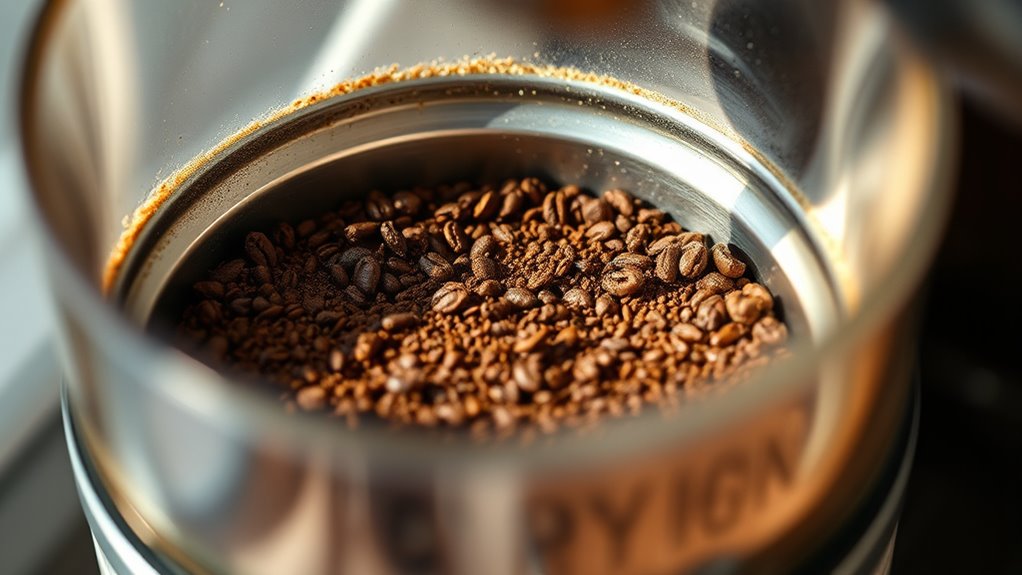
Residual coffee left in the grinder can considerably influence the flavor and aroma of your espresso. Over time, old grounds can introduce stale notes, dulling the bright qualities you seek. This impacts the overall taste, especially if brewing temperature isn’t ideal or water quality varies. To prevent this:
Residual coffee in your grinder dulls flavor and aroma over time.
- Clean your grinder regularly to remove lingering grounds.
- Ensure consistent brewing temperature for better extraction.
- Use high-quality water to avoid mineral buildup that affects flavor.
- Minimize residual coffee to preserve the coffee’s natural aroma and nuanced flavors.
Common Causes of Excess Grind Retention

Understanding the common causes of excess grind retention can help you troubleshoot and optimize your espresso workflow. One major factor is grinder calibration; if your grinder isn’t properly calibrated, it may produce inconsistent grind particle size, causing some grounds to stick. Fine grind sizes tend to compact more, increasing retention, especially if your burrs are misaligned or worn. Additionally, uneven grind distribution can lead to clumping and retention issues. Overly tight adjustment settings or worn burrs can also hinder grounds from exiting smoothly. Regularly checking and adjusting your grinder calibration ensures uniform particle size and reduces retention. Proper burr alignment and maintenance are essential for minimizing leftover coffee in your grinder. By addressing these common causes—particularly grind particle size and calibration—you’ll improve extraction consistency and minimize leftover coffee in your grinder.
Techniques for Measuring and Reducing Retention
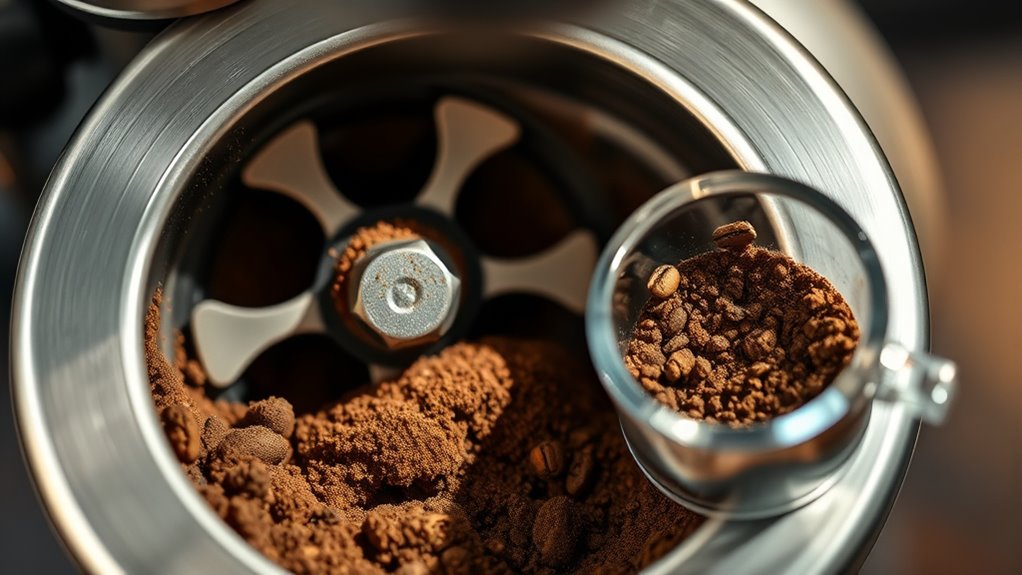
To effectively measure grind retention, you should use precise methods like weighing doses before and after grinding or employing specialized tools. Regularly cleaning your grinder with optimized practices helps prevent buildup that increases retention. Additionally, using headphone repair techniques can help maintain consistent performance and prevent issues that may affect the grinding process. Combining accurate measurement techniques with consistent cleaning ensures you can identify issues and keep retention to a minimum.
Precise Measurement Methods
Accurately measuring grinder retention is essential for optimizing espresso quality, and several precise techniques can help you achieve this. First, adjust your grind size and dose consistently, noting how much coffee remains after grinding. Second, perform a test grind with a known dose, then weigh the leftover grounds to determine retention. Third, use a clear container or dosing cup to catch the grind and measure the retained amount directly. Fourth, compare different grind sizes and dosing techniques to see how they impact retention levels. By refining your grind size and dosing methods based on these measurements, you can minimize retention and improve shot consistency. Understanding grinder behavior through precise measurement helps you understand your grinder’s behavior and tailor your approach effectively.
Optimized Cleaning Practices
Effective cleaning practices directly impact your grinder’s retention levels and, ultimately, your espresso quality. Regularly cleaning your grinder removes residual coffee and oils that build up, which can cause inconsistent grind sizes and increased retention. To maximize results, calibrate your grinder frequently to ensure consistent particle size, especially after deep cleaning. Using fresh beans also minimizes buildup and retention, as stale beans tend to leave more residue. When cleaning, focus on thorough hopper and burr chamber scrubbing, removing any trapped grounds. Don’t forget to check and adjust grinder calibration after cleaning to maintain ideal grind consistency. These practices help reduce retention, ensuring fresh grounds are delivered consistently and your espresso retains its vibrant flavor. Additionally, understanding resources and tools available can help you implement these maintenance routines more effectively.
Best Practices for Grinder Maintenance and Cleaning
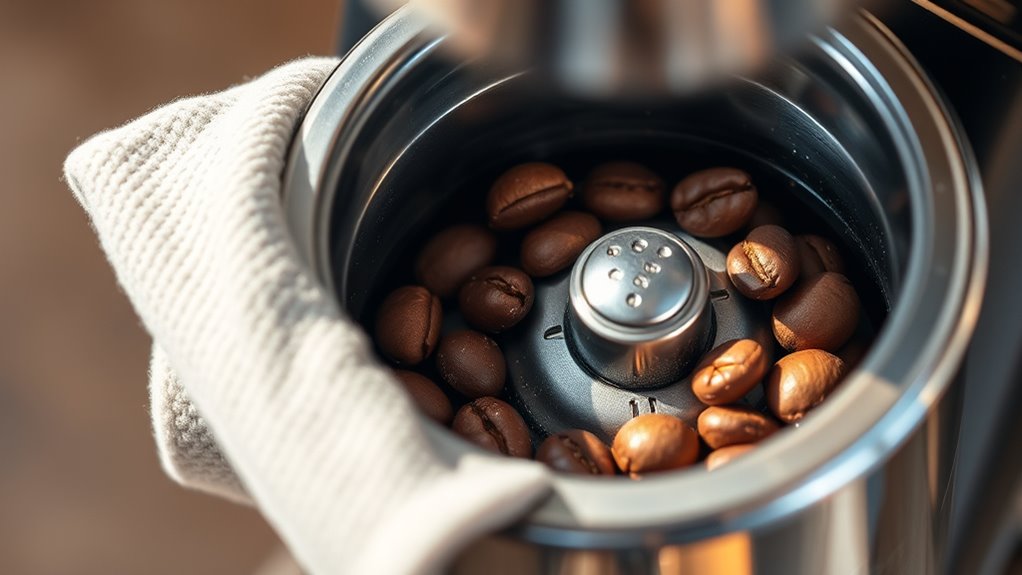
Regular maintenance and cleaning of your espresso grinder are essential for ensuring consistent grind quality and prolonging its lifespan. To achieve this, follow these best practices:
- Regularly calibrate your grinder to maintain grind size consistency, especially after cleaning or changing burrs.
- Clean burrs and doser chambers weekly to prevent buildup that can affect grind retention.
- Use proper cleaning tools and brushes to remove coffee oils and residues, which can impact flavor and retention.
- Schedule deep cleans monthly, including disassembling parts if necessary, to keep the grinder functioning smoothly.
- Be aware that Gold IRA regulations and best practices can influence your choices when investing in precious metals, ensuring your investments remain compliant and secure.
Practical Tips to Keep Your Coffee Fresh and Consistent
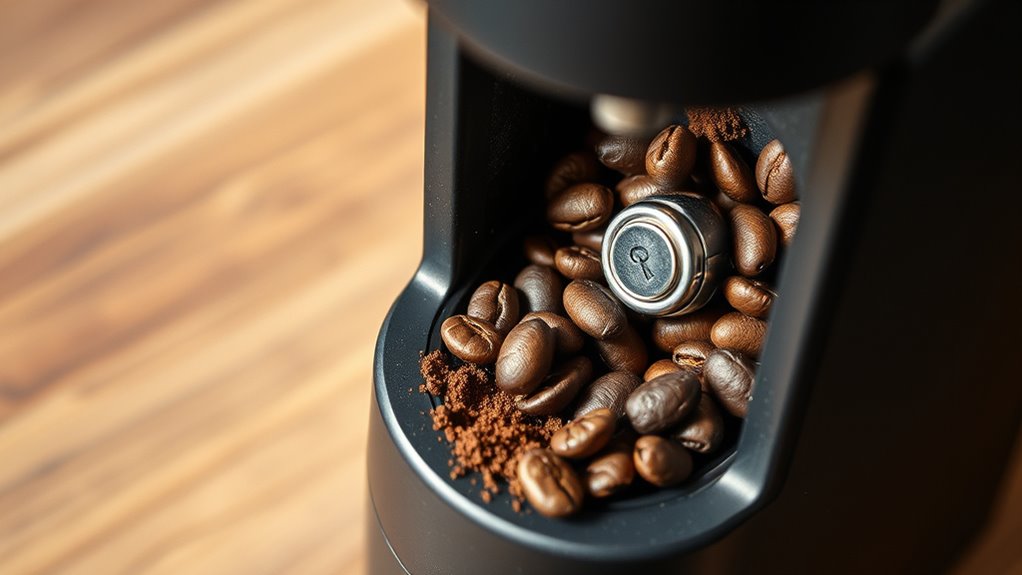
Keeping your coffee fresh and consistent starts with proper storage and handling. Store beans in an airtight container away from light, heat, and moisture to preserve freshness. Use freshly roasted beans with a reputable coffee certification to guarantee quality. Pay attention to brewing temperature; maintaining a stable, ideal temperature (around 195-205°F) helps extract flavors evenly, preventing over- or under-extraction that can compromise consistency. Grind just before brewing to lock in aroma and flavor. Consistent grind size reduces variability in extraction. Additionally, measure your coffee precisely each time to avoid fluctuations. These simple steps help maintain the integrity of your beans, ensuring each shot tastes as good as the last. Proper storage, brewing temperature, and certification are key to reliable, fresh coffee. Incorporating a high-quality modern shower setup in your bathroom can also enhance relaxation and overall home ambiance.
Troubleshooting Retention Issues in Different Grinder Types
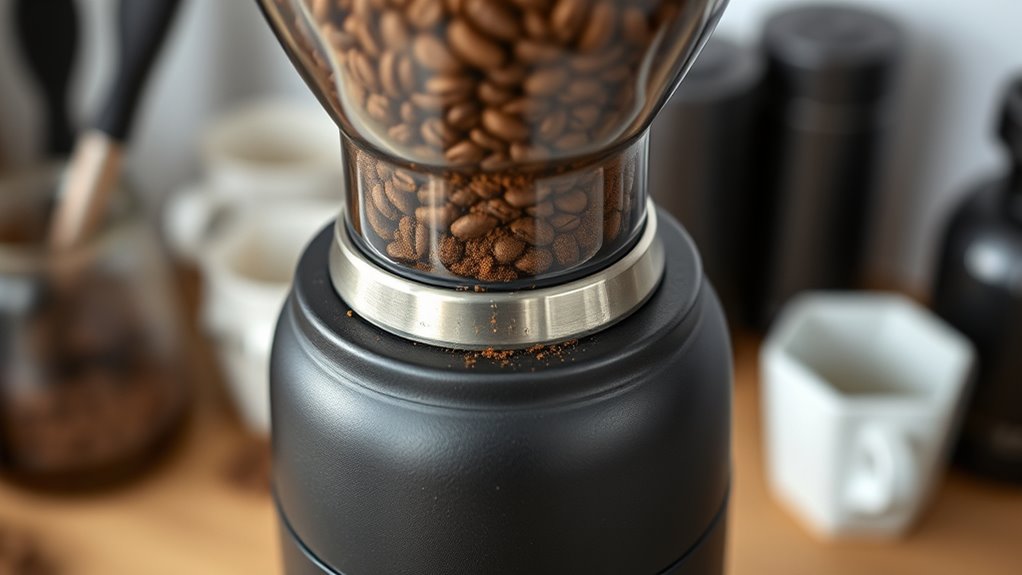
Even with proper storage and handling, grinder retention can still cause inconsistencies in your coffee. Different grinder types require specific troubleshooting.
- For burr grinders, check grinder calibration regularly to ensure consistent particle size and reduce retention.
- For blade grinders, clean the chamber often, as leftover grounds impair bean freshness and cause uneven extraction.
- For flat burr models, inspect burr alignment; misalignment increases retention and affects grind quality.
- For conical burr grinders, adjust grind settings gradually to prevent buildup and optimize bean freshness.
Addressing retention involves understanding your grinder’s design and maintaining it properly. Regular cleaning and calibration help prevent old grounds from mixing with fresh beans, ensuring uniform extraction and a better espresso shot.
Frequently Asked Questions
Can Grind Retention Affect the Temperature of Brewed Espresso?
Yes, grind retention can affect the temperature of brewed espresso. When grind retention causes uneven grind uniformity, it can lead to temperature fluctuations during extraction. Residual coffee in the grinder may warm up or cool down, impacting the consistency of your espresso shot. To maintain stable temperature and ideal flavor, regularly clean your grinder and guarantee consistent grind size, reducing retention issues that disrupt the brewing process.
How Does Grind Retention Influence Shot Timing and Extraction Consistency?
Grind retention impacts shot timing and extraction consistency because leftover grounds can cause uneven flow and clogging. If your grind size is too fine, or if tamp pressure isn’t consistent, retained grounds can slow extraction, leading to longer shot times and uneven flavors. Regularly cleaning your grinder, adjusting grind size, and applying steady tamp pressure help minimize retention’s effects, ensuring more consistent shots and proper extraction.
Are There Specific Grinder Features That Minimize Retention Effectively?
Look for grinders with a well-designed burr system and optimized grind path, as these features minimize retention. Conical burrs often reduce leftover coffee compared to flat burrs, and a smooth grind path helps prevent buildup. Also, choose grinders with easy-to-clean components, so you can regularly clear out residual coffee. These features work together to lower retention, ensuring fresher grounds and more consistent espresso shots.
Can Grind Retention Cause Uneven Coffee Extraction in Multi-Shot Routines?
Think of grinder retention as hidden pockets of coffee bean oils lurking in your machine. Yes, retention can cause uneven extraction in multi-shot routines, like a rough terrain disrupting a smooth ride. When oils cling to the grinder, they affect calibration, leading to inconsistent grind sizes. Regular cleaning and proper calibration make certain that every shot is uniform, preventing those pesky uneven pulls and delivering a balanced espresso every time.
How Does Ambient Humidity Impact Grind Retention and Coffee Freshness?
Ambient humidity directly impacts grind retention and coffee freshness. Higher humidity can cause coffee grounds to clump, increasing retention and making it harder to achieve consistent grind size. Conversely, low humidity helps maintain grind uniformity and preserves freshness by preventing moisture absorption. To combat humidity fluctuations, use humidity control methods like airtight storage and maintain a stable environment, ensuring your coffee stays fresh and your grinder performs consistently.
Conclusion
Understanding grind retention might seem small, but it’s the secret to consistently fresh coffee. While your grinder’s tiny pockets hold onto leftover grounds, letting them sit can dull your brew’s flavor. Embrace regular cleaning and mindful technique, turning a routine task into a craft. Because in coffee, just like in life, what you hold onto can make all the difference—sometimes keeping too much behind is what keeps your coffee from shining.

